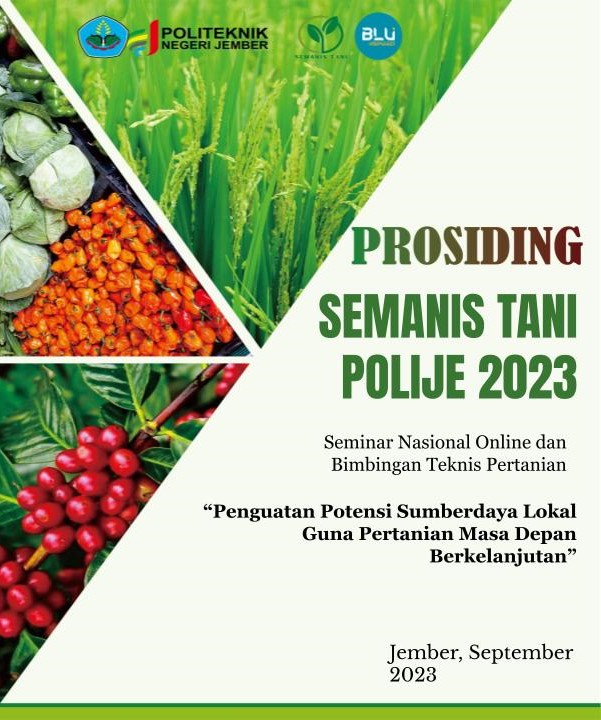Respon Pertumbuhan Bibit Kelapa Sawit ( Elais Guineensis Jacq.) Varietas DxP Simalungun Terhadap Aplikasi PGPR dan Trichoderma sp. Di Pre Nursery
DOI:
https://doi.org/10.25047/agropross.2023.487Kata Kunci:
PGPR, Trichodeerma sp, Kelapa Sawit, Pre NurseryAbstrak
Nurseries are important and play a major role in the development of upstream to downstream industries in oil palm plantations. One of the supporting factors affecting the productivity of oil palm plantations is the use of superior seeds. So far, there are still many oil palm nurseries that pay little attention to the type of soil used. The use of organic matter can be used to improve soil quality in terms of physical, chemical and biological properties as a place for growing oil palm seeds. Organic materials can increase the number of bacteria in the soil so that their use is more effective than just providing inorganic fertilizers. The purpose of this study was to determine the effect of PGPR and Trichoderma sp. on the growth of oil palm seedlings in the pre nursery phase. The implementation of the research entitled “Growth Response of Oil Palm Seeds (Elais guineensis Jacq.) DxP Simalungun Variety to the Application of PGPR and Trichoderma sp. In Pre-Nursery.” It will be held from July to November 2022 at the Plant and Field Protection Laboratory, Department of Agricultural Production, at an altitude of 104 meters above sea level. This study used a non-factorial randomized block design (RBD) consisting of 4 treatments. As for each treatment, P0: without the application of PGPR and Trichoderma sp. P1 : application of PGPR (density 105 CFU) P2 : application of Trichoderma sp. (density 108 spores/ml) P3 : PGPR application (density 105CFU) + Trichoderma sp. (density 108 spores/ml). Observational data were analyzed using analysis of variance (ANOVA), then it was tested further with LSD (Lessest Significant Difference) 5%. The results of this study indicate that the application of PGPR + Trichoderma sp. significant effect on the parameters of plant height at 11 WAP, stem diameter at 5, 7, 11 WAP, root volume at 11 WAP and highly significant effect on the number of leaves parameter at 9 and 11 WAP. The best treatment was the application of PGPR (density 105 CFU) + Trichoderma sp. (density 108 spores/ml) (P3)
Unduhan
Referensi
Afrizon. (2017). Pertumbuhan Bibit Kelapa Sawit (Elaeis guineensis Jacq.)
Dengan Pemberian Pupuk Organik dan Anorganik. Jurnal Ilmu Dan
Teknologi Pertanian, 4(1), 95–105.
Azarmi, R., Hajieghrari, B., & Giglou, A. (2011). Effect of Trichoderma isolates
on tomato seedling growth response and nutrient uptake. African Journal
of Biotechnology, 10(31), 5850–5855.
Bot, A., & Benites, J. (2005). The importance of soil organic matter: Key to
drought-resistant soil and sustained food production (Issue 80). Food &
Agriculture Org.
Cornejo, Macías-Rodríguez, L., Del-Val, E., & Larsen, J. (2016). Ecological
Functions of Trichoderma spp. and Their Secondary Metabolites in The
Rhizosphere:Iinteractions WithPlants. Journal FEMS Microbiol. Ecol,
(4), 1–17.
Devago. (2005). Biological control of soil-borne pathogens by fluorescent
pseudomonads. Journal Nature Reviews Microbiology 3, 307–319.
Hanafiah. (2005). Dasar-dasar Ilmu Tanah (1st ed.). Raja Grafindo Persada.
Jakarta.
Hardjowigeno, S. (2003). Ilmu tanah ultisol. Edisi Baru. Akademika Pressindo,
Jakarta.
Juliani, R., Simbolon, R. F. R., Sitanggang, W. H., & Aritonang, J. B. (2017).
Pupuk Organik Eceng Gondok dari Danau Toba. Jurnal Pengabdian
Kepada Masyarakat, 23(1), 220–224.
Khamili. (2009). Pemanfaatan PGPR untuk Biostimulans dan Bioprotectants.
Jurnal Ecotropik, 2(4), 131–135.
Pelczar, M. J., & Chan, E. C. S. (2005). Dasar-dasar Mikrobiologi 1. Ahli
Bahasa: Hadioetomo, R. S, Imas, T., Tjitrosomo, SS dan Angka. SL UI
Press, Jakarta.
Rahni, N. M. (2012). Efek Fitohormon PGPR Terhadap Pertumbuhan Tanaman
Jagung (Zea mays). CEFARS : Jurnal Agribisnis Dan Pengembangan
Wilayah, 3(2), 27–35.
Sarif. (1985). Respon Pertumbuhan Bibit Kelapa Sawit Pre Nursery terhadap
Macam dan Dosis Pupuk Nitrogen di Sub Soil Latosol. Skripsi.
Universitas Mercu Buana, Yogyakarta.
Santiago, L. S., & Mulkey, S. S. 2005. Leaf productivity along a precipitation gradient in lowland Panama: Patterns from leaf to ecosystem. Trees - Structure and Function, 19(3), 349–356.
Sepwanti, C., & Rahmawati, M., (2016). Pengaruh varietas dan dosis kompos
yang diperkaya Trichoderma harzianum terhadap pertumbuhan dan hasi
tanaman cabai merah (Capsicum annuum L.). Jurnal Kawista 1(1), 68–74.
Shofiah, D. (2016). Aplikasi PGPR (Plant Growth Promoting Rhizobacteria) dan
pupuk kotoran kambing pada pertumbuhan dan hasil bawang merah
(Allium ascalonicum L.) Skripsi. Universitas Brawijaya Malang
Sipahutar, A., Marbun, P., & Fauzi, F. (2014). Kajian C-Organik, N Dan P
Humitropepts Pada Ketinggian Tempat Yang Berbeda Di Kecamatan
Lintong Nihuta. Jurnal Agroekoteknologi. 2(4), 100824.
Six, J., Elliott, E. T., Paustian, K., & Doran, J. W. (1998). Aggregation and soil
organic matter accumulation in cultivated and native grassland soils. Soil
Science Society of America Journal, 62(5), 1367–1377.
Utami, A. P., Agustiyani, D., Handayanto, E., (2018). Pengaruh PGPR (Plant
Growth Promoting Rhizobacteria), kapur, dan kompos pada tanaman
kedelai di ultisol Cibinong, Bogor. Jurnal Tanah Dan Sumberdaya Lahan,
(1), 2549–9793.
Wahyuningsih, E., Herlina, N., & Tyasmoro, S. Y. (2017). Pengaruh pemberian
PGPR (Plant Growth Promoting Rizhobacteria) dan pupuk kotoran kelinci
terhadap pertumbuhan dan hasil tanaman bawang merah (Allium
ascalonicum L.). Jurnal Produksi Tanaman, 5(4), 591–599. 9(4), 284–287.
Unduhan
Diterbitkan
Cara Mengutip
Terbitan
Bagian
Lisensi
Hak Cipta (c) 2023 Mohammad Faris Madani, Irma Wardati

Artikel ini berlisensi Creative Commons Attribution 4.0 International License.
Hak cipta (Copyright) artikel yang dipublikasikan di Agropross : National Conference Proceedings of Agriculture dipegang oleh penulis (Copyright by Authors) di bawah Creative Commons Attribution 4.0 International License (CC-BY). Sehingga penulis tidak memerlukan perjanjian pengalihan hak cipta yang harus diserahkan kepada redaksi.






